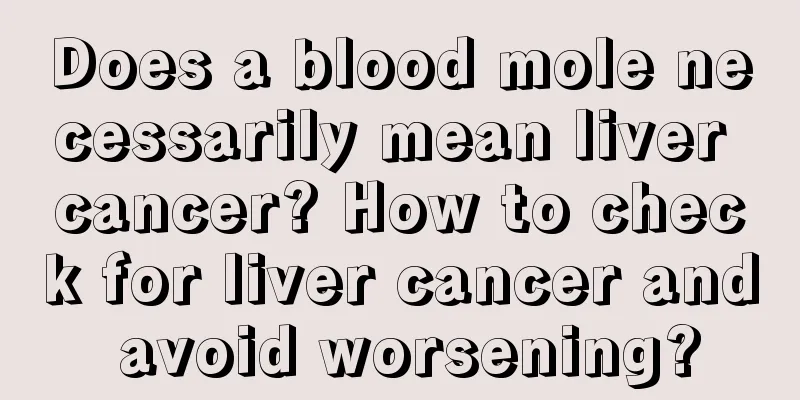Mid-term symptoms of colon cancer

|
Symptoms of mid-stage colon cancer: Due to the blood loss and toxin absorption caused by tumor ulceration, patients often experience anemia, low fever, fatigue, weight loss, edema, etc., especially anemia and weight loss. Let's take a closer look at this aspect. Most patients with colon cancer are middle-aged or older, with a median age of 45, and about 5% of patients are under 30 years old. The clinical manifestations of colon cancer vary with the size, location and pathological type of the lesions. Many patients with early colon cancer may have no clinical symptoms, but as the disease progresses and the lesions continue to grow, they may develop a series of common symptoms of colon cancer, such as increased frequency of bowel movements, blood and mucus in the stool, abdominal pain, diarrhea or constipation, intestinal obstruction, general fatigue, weight loss and anemia. The entire colon is divided into two parts, the right colon and the left colon, by the middle of the transverse colon. The clinical manifestations of these two cancers do have their own characteristics, which are described as follows: The left colon has a narrower lumen, and the stool in the intestine becomes dry and hard due to water absorption. Most left colon cancers are invasive, often causing annular stenosis, so the clinical manifestations are mainly acute and chronic intestinal obstruction. The tumor is small in size, with less ulceration and bleeding, and no toxin absorption, so anemia, weight loss, cachexia and other phenomena are rare, and it is not easy to palpate the tumor. 1. Difficulty in defecation Half of the patients have this symptom, and as the disease progresses, the constipation becomes more severe. If the tumor is located lower, there may also be difficulty in defecation and a feeling of tenesmus. 2. Blood or mucus in the stool. As the stool in the left colon gradually takes shape, blood and mucus are not mixed with the stool. In about 25% of patients, blood and mucus can be seen in the stool by naked eye. 3. Abdominal colic is the main manifestation of intestinal obstruction associated with cancer. Obstruction may occur suddenly, with abdominal colic, accompanied by abdominal distension, hyperperistalsis, constipation and obstructed flatulence. Chronic obstruction manifests as abdominal distension, paroxysmal abdominal pain, hyperactive bowel sounds, constipation, blood and mucus in stool. Partial intestinal obstruction sometimes lasts for several months before turning into complete intestinal obstruction. The right colon cavity is enlarged, and the stool in the intestine is liquid. The cancer in this section of the intestine is mostly ulcer-type or cauliflower-shaped cancer that protrudes into the intestinal cavity. There is rarely annular stenosis, so obstruction does not often occur. However, these cancers often rupture and bleed, and secondary infections are accompanied by toxin absorption. Therefore, clinically, there may be changes in stool, abdominal pain and discomfort, abdominal mass, anemia, weight loss or cachexia. 1. Stool changes: Early stool is thin, contains pus and blood, and the frequency of defecation increases, which is related to the formation of cancer ulcers. When the tumor volume increases, it affects the passage of stool, and diarrhea and constipation may occur alternately. The amount of bleeding is small, and it is fully mixed with stool as the colon moves, which is not easy to see with the naked eye, but the occult blood test is often positive. 2. Abdominal pain and discomfort About 75% of patients have abdominal discomfort or dull pain, which is intermittent at first and then becomes continuous, often located in the right lower abdomen, which is very similar to the attack of chronic appendicitis. If the tumor is located in the hepatic flexure and the stool is dry and hard, colic may also occur, which should be distinguished from chronic cholecystitis. About 50% of patients have loss of appetite, fullness, belching, nausea and vomiting. 3. Abdominal mass More than half of the patients can find abdominal mass when they seek medical treatment. This mass may be the cancer itself, or it may be a mass formed by extraintestinal infiltration and adhesion. The former has a more regular shape and clear outline; the latter has an irregular shape. The mass is generally hard in texture, and once secondary infection occurs, the movement is restricted and there is tenderness. 4. Anemia and cachexia About 30% of patients develop anemia due to continuous bleeding from cancer rupture, and also experience weight loss, limb weakness, and even systemic cachexia. The above is the knowledge about colorectal cancer that we have prepared for you today. I hope it will be helpful to you. If you have any other questions, you can also consult our online consulting experts of Feihua Health Network. We are always here to answer your questions. Feihua Health Network is always by your side to care about your health issues! I wish you good health! Bowel cancer: |
<<: Knowledge collection for gastric cancer diagnosis
>>: Radiotherapy and chemotherapy for cervical cancer
Recommend
Why do I feel anxious after radiotherapy for nasopharyngeal carcinoma
Why do I feel anxious after radiotherapy for naso...
What causes cough with thick phlegm?
Cough is a common disease for babies, but most ba...
Nail crescent-shaped
People usually have half-moons on their nails. Fo...
What's the matter with thick arms
Everyone wants to have a slim figure and hopes th...
Treatment methods for breast cancer in four different stages
There are many effective treatments for breast ca...
What are the precautions for leep knife surgery
Medical technology is developing rapidly now, and...
An optimistic attitude helped him get out of the shadow of meningioma
In 1999, due to an epileptic seizure, 19-year-old...
There are teeth marks on my tongue when I wake up in the morning
When you wake up in the morning, if there are too...
Is the mosquito killer lamp harmful to babies?
Summer is the time when there are the most words,...
What's the matter with walking crookedly
We start learning the skills of walking in early ...
How are eye bags formed? Make your own cucumber eye mask to get rid of eye bags
I don’t know if it’s because of my age or because...
What are the symptoms and diagnosis of pancreatic cancer
Pancreatic cancer is a common pancreatic tumor. I...
What are the magical uses of egg white
It is generally recognized that egg white can bea...
What causes sweaty armpits?
The armpits are prone to sweating, which sometime...
What are the folk remedies for lung cancer that have the effect of detoxification and dispersing nodules?
Lung cancer patients may suffer from blood stasis...









